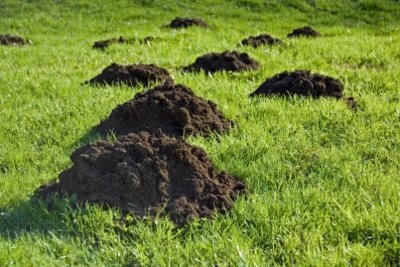Holes in the lawn from an animal
If your own meadow suddenly looks more like a crater field than an English lawn, good advice is often expensive. In the following text you will find remedies for holes in the lawn and the animal that is behind them.

Holes in the lawn - which animal was it?
Holes in race can be caused by a wide variety of animals. To be able to take effective countermeasures, you must first determine which animal is up to mischief in your garden.
- If holes only a few millimeters in size appear in the lawn in spring and autumn, the animal is not particularly beautiful to look at, but very useful: the earthworm. The small piles of earth on the lawn holes are the best compost soil.
- About 2 cm large holes in the grass that do not go particularly deep could be through Hedgehog or caused by birds. These dig up grubs and other larvae, leaving bald spots in the lawn.
- Holes in the lawn that are 3 to 5 cm in diameter and end in unfathomable passages indicate mice or field mice. Larger holes can also be made by Rats originate, but these are found less often on the lawn.
- Holes covered by mounds of earth can come from voles and moles.
- Holes dug up in the lawn that appear scratched at least on the surface often come from animals such as raccoons, badgers or foxes. In the hunt for the actual inhabitants of the corridors, they enlarge the entrances. However, this type of hole is very rare in gardens.
Dry lawn - what to do?
Many garden owners often have the same problem - dry lawn after ...
Animal holes in the meadow - how to act?
- Find out if the holes in your lawn really come from an animal, including dying moss and weed as well as over-fertilization or insufficient nutrients in the soil can leave bald spots.
- Always drive away animals starting in the middle of the garden. This allows them to escape outside and not be cornered in the garden.
- If you are not sure which species of animal has perforated your lawn, you should take photos of the affected areas. To illustrate the size of the hole, you can place a coin or ruler next to the hole. Use the photos to ask in garden centers or nurseries - there are often experienced specialists there who know which animal was at work.
- Not all holes in the lawn and the associated animal require treatment. So you don't have to do anything against earthworms, birds or hedgehogs. Hook up the loose soil of the earthworm holes, simply pin loose pieces of lawn back in place or provide bare spots with new lawn seeds. Even if the holey green doesn't look nice at first, earthworms keep the soil healthy in the long term, while birds and hedgehogs protect against beetle plagues.
- To protect against moles and voles, you can use so-called fright devices, which are also commercially available with solar power. These devices are plugged into the ground and produce different tones that make your garden unattractive for the animals.
- If your lawn is infested with field mice, mice or rats, you will also find keep-away systems for this. Before resorting to expensive equipment or poisons, however, you can try natural remedies. Fill cat and dog fur hair, used cat litter or pepper into the entrances and seal the holes. If the mouse infestation recurs, it also helps to make the floor unattractive. Use stone slabs or pieces of wire, this will force them Mice to diversions and eventually deny them digging. You should be particularly careful with wild rats, and according to the Federal Disease Protection Act, they are notifiable.
- With recurring animal holes and passages in the lawn, it may be necessary to dig up the entire grass area. This will destroy buildings and corridor systems. Windfalls should also be removed from the lawn regularly so that it does not attract animals.
How helpful do you find this article?



